Bennemann K.H., Ketterson J.B. Superconductivity: Volume 1: Conventional and Unconventional Superconductors; Volume 2: Novel Superconductors
Подождите немного. Документ загружается.

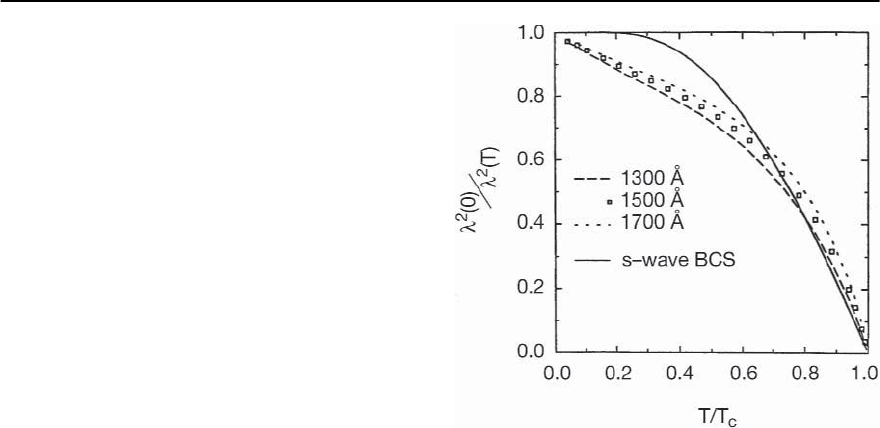
13 Unconventional Superconductivity in Novel Materials 731
erally consistent with a superconducting state with
d
x
2
−y
2
or extended s-wave symmetry for the hole-
dopedcupratessuchasYBCO–123,YBCO–124,LSCO,
and BSCCO. Experiments discussed below indicate
a dominant component of d
x
2
−y
2
symmetry in the
superconducting order parameter of hole–doped
cuprates.
Shown in Fig. 13.96 are data for [(0)/(T)]
2
vs
T/T
c
,where is the London penetration depth for a
YBa
2
Cu
3
O
6.95
single crystal from the work of Hardy
et al. [612]. The data clearly deviate from the BCS s-
wave behavior (solid line in the figure)and are linear
in T at low temperatures. The linear behavior is con-
sistent with the existence of line nodes in the energy
gap of a clean d-wave superconductor.
Early electron tunneling [621], microwave pen-
etration depth [622, 623], and Raman spec-
troscopy [624] measurements on the electron-doped
superconductor NCCO indicated that the supercon-
ducting order parameter of this material has s-wave
symmetry. Superconductivity with d-wave symme-
try for hole-doped cuprates and s-wave symmetry
for electron-doped cuprates seems rather surpris-
ing, in view of the similarities in the structures of
the hole-doped and electron-doped superconductors
and the fact that they are both derived from chemical
substitution of AFM insulating parent compounds.
However, more recent microwave [625,626], angle-
resolved photoemission spectroscopy (ARPES) [627,
628],and phase sensitive SQUID microscope (see be-
low) [629] experimentsappeartobeconsistentwith a
d-wave superconducting order parameter.According
to Blumberg et al.[630],who recently performed low
energy electronic Raman scattering measurements
on NCCO single crystals, these seemingly contradic-
tory results can be rationalized in terms of a non-
monotonic form of the d
x
2
−y
2
order parameter. The
superconducting gap opens up rapidly with depar-
ture from the diagonal nodal directions and reaches
a maximum value of 4.4k
B
T
c
at the hot spots that
are located closer to the nodes than to the Brillioun
zone boundaries where the gap drops to 3.3k
B
T
c
.
Theenhancementofthegapvalueintheproxim-
ity of the hot spots emphasizes the role of antifer-
romagnetic spin fluctuations for superconductivity
in the electron-doped cuprates. Thus, despite strong
Fig. 13.96. Ratio [(0)/(T)]
2
extracted from measure-
ments of (T)onaYBa
2
Cu
3
O
6.95
single crystal, a mea-
sure of the superfluid density. The different choices of (0)
(square and long and short dashed curves) used have little
effect on the overall shape. The strong linear behavior at
low temperatures is clearly different from the s-wave BCS
result, after [612]
differences between the electron- and hole-doped
cuprates, their superconductivity may have the same
order parameter symmetry and originate from a sim-
ilar mechanism.
Phase of the SuperconductingOrder Parameter
Several differenttypes of measurements that are sen-
sitive to the phase of (k) have been performed.
These measurements,all of which involve the Joseph-
son effect, include superconducting quantum inter-
ference device (SQUID) interferometry [631–633],
single junction modulation [634,635], tricrystal ring
magnetometry [636–638], c-axis Josephson tunnel-
ing [639–643], and grain boundary tunneling [644].
The SQUID interferometry, single junction modu-
lation, and tricrystal ring magnetometry measure-
ments were performed on YBCO, while tricrystal
magnetometry experiments have also been carried
out on TBCCO. These experiments indicate that the
superconducting order parameter in the YBCO and
TBCCO hole-doped materials has d
x
2
−y
2
symmetry.

732 M.B. Maple et al.
However,c-axis Josephson tunneling studieson junc-
tions consisting of a conventional superconductor
(Pb) and twinned or untwinned single crystals of
YBCO indicate that the superconducting order pa-
rameter of YBCO has a significant s-wave compo-
nent [639,640].As noted above, tricrystal ring mag-
netometry measurements indicate d-wave symmetry
for the electron-doped superconductor NCCO [645]
which, according to recent low energy polarized elec-
tronic Raman scattering studies,has a nonmonotonic
d
x
2
−y
2
superconducting order parameter [630].
Anewtypeofc-axis Josephson tunneling exper-
iment in which a conventional superconductor (Pb)
was deposited across a single twin boundary of a
YBCO single crystal was performed by Kouznetsov
et al. [646]. The Josephson critical current I
c
was
measured as a function of magnitude and angle
of magnetic field applied in the plane of the sample.
For H aligned perpendicular to the twin boundary,
a maximum in I
c
as a function of H was observed at
H =0,whereasforH parallel to the twin boundary,
a minimum in I
c
was observed at H =0.Inallsam-
ples investigated,a clear experimental signature of an
order parameter phase shift across the twin bound-
ary was observed. The results provide evidence for
mixed d and s-wave pairing in YBCO and are con-
sistent with predominant d-wave pairing with d
x
2
−y
2
symmetry and a sign reversal of the s-wave compo-
nent across the twin boundary.
Recently, Bi
2
Sr
2
CaCu
2
O
8−ı
(Bi2212) bicrystal c-
axis twist Josephson junction experiments were per-
formed and taken as evidence for a dominant s-wave
order parameter for T < T
c
[647,648].The twist an-
gle
0
independence of the c-axis Josephson critical
current J
c
across the twist junction for T just below
T
c
was interpreted in terms of a dominant s-wave or-
der parameter for all T ≤ T
c
. This experiment is in
apparent contradiction to the results of the tricrystal
experiments on Bi2212 which indicated a dominant
d
x
2
−y
2
wave order parameter component in Bi2212
at low temperatures for both under-doped and over-
doped samples [645]. It was recently suggested that
these experiments would be compatible if the super-
conductivity exhibited by Bi2212 were mostly s-wave
in the bulk and d-wave on the surface [649]. Critical
discussions of these and other phase sensitive ex-
periments on Bi2212 can be found in several recent
papers (for example, [650,651])
Various mixed s and d-wave pairing models that
have been developed to account for the supercon-
ducting properties of the orthorhombic YBCO–123
system are reviewed by B´eal–Monod [652].
Multiple Superconducting States
An anomaly in the thermal conductivity at
low temperature of the high T
c
superconductor
Bi
2
Sr
2
Ca(Cu
1−x
Ni
x
)
2
O
8
was reported by Movshovich
et al. [653]. The anomaly takes the form of a sharp
reduction of at a temperature T
∗
c
≈200 mK, which
separates a higher temperature region where varies
as T
˛
with ˛ between 1.6 and 1.75 and a lower tem-
perature region where is linear in T.Thelowtem-
perature anomaly was found to be suppressed by the
application of a small magnetic field. Movshovich
et al. proposed that the observed behavior is con-
sistent with a phase transition into a second bulk
low temperature superconducting state at T
∗
c
.They
note that the presence of a second superconducting
state would constitute direct evidence for unconven-
tional superconductivity in Bi
2
Sr
2
CaCu
2
O
8
.Asnoted
in Sect. 13.3, multiple superconducting states have
been observedin the heavy fermionsuperconductors
UPt
3
and U
1−x
Th
x
Be
13
in which the superconducting
electrons are also believed to be paired in states with
finite angular momentum.
13.5.5 Normal State Properties
It was realized at the outset that the normal state
properties of the high T
c
cuprate superconductors
are unusual and appear to violate the Landau Fermi
liquid paradigm [654–658]. Some researchers share
the view that it will be necessary to develop an un-
derstanding of the normal state before the supercon-
ducting state can be understood, since the normal
state properties reflect the electronic structure that
underlies high T
c
superconductivity.
The anomalous normal state properties first iden-
tifiedin the high T
c
cuprate superconductorsinclude
the electrical resistivity and Hall effect. The elec-
trical resistivity
ab
(T)intheab-plane of many of
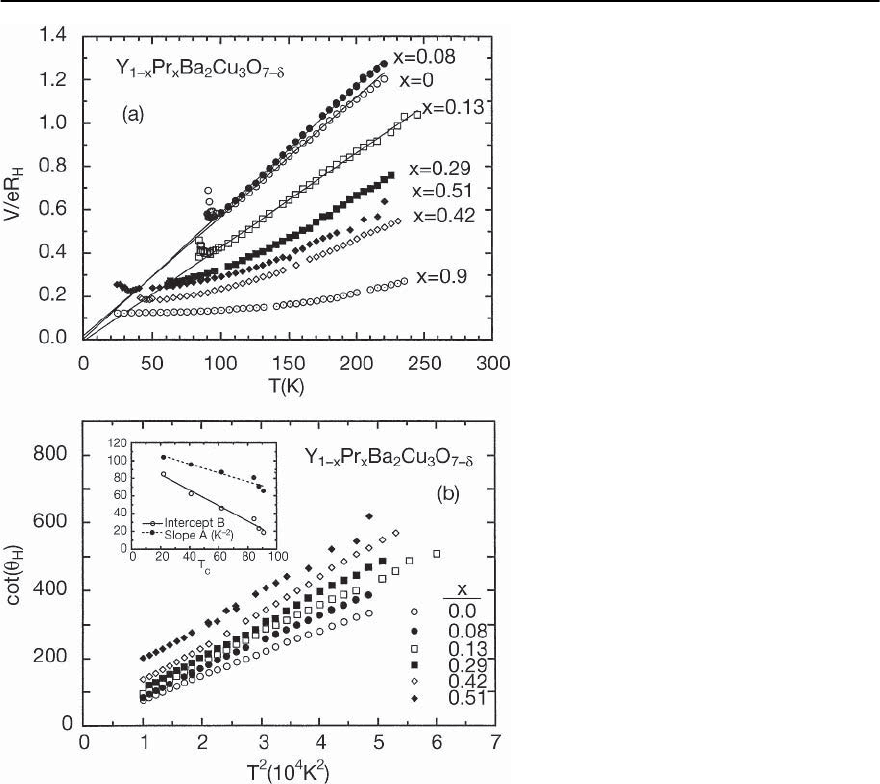
13 Unconventional Superconductivity in Novel Materials 733
Fig. 13.97. (a) Temperature dependence of
the Hall carrier number n
H
= V/eR
H
for
Y
1−x
Pr
x
Ba
2
Cu
3
O
7−ı
single crystals with differ-
ent x values.The fact that the data for two pairs
of x values (x =0,x =0.08, and x =0.42,
x =0.51) are out of sequence in the V/eR
H
vs
T plot,but not in the cot(
H
)vsT
2
plot (see (b)),
could be a result of the error in measuring the
thickness of these crystals. The x =0.9value
represents the nominal composition, while the
x values of the superconducting samples were
estimated by comparing the T
c
’s of the crys-
tals with those of high quality polycrystalline
samples.After [282]. (b) Cotangent of the Hall
angle cot(
H
)vsT
2
of Y
1−x
Pr
x
Ba
2
Cu
3
O
7−ı
sin-
gle crystals with magnetic field H =6teslaand
H c, after [661]
the hole-doped cuprate superconductors near opti-
mal doping has a linear temperature dependence be-
tween T
c
and high temperatures ∼ 1000 K, with an
extrapolated residual resistivity
ab
(0) that is very
small; i.e.,
ab
(T) ≈
ab
(0) + cT,with
ab
(0) ≈ 0
and the value of c similar within different classes of
cuprate materials [659]. An example of the linear T-
dependence of
ab
(T) is displayed in Fig. 13.91(a)
for the Y
1−x
Pr
x
Ba
2
Cu
3
O
7−ı
system [282]. In con-
trast, both
ab
(T)and
c
(T) of the optimally-doped
electron-doped cuprate Sm
1.83
Ce
0.17
CuO
4−y
vary as
T
2
, indicative of three dimensional Fermi liquid be-
havior in the La
2−x
M
x
CuO
4
systems [660].
The Hall coefficient R
H
is inversely proportional
to T and the cotangent of the Hall angle
H
= R
H
/
varies as T
2
; i.e., cot
H
=
xx
/
xy
= AT
2
+ B [662].
This is illustrated in Fig. 13.97 which contains a
plot of
H
vs T
2
calculated for a field of 6 tesla
for Y
1−x
Pr
x
Ba
2
Cu
3
O
7−ı
single crystals [661]. The lin-
ear T-dependence of (T)andthequadraticT-
dependence of cot(
H
) have been attributed to lon-
gitudinal and transverse scattering rates
−1
and
−1
t
that vary as T and T
2
, respectively [663]. In the
RVB model, the constant and T
2
terms in
−1
t
and,
in turn,
H
, are ascribed to scattering of spinons by
magnetic impurities and other spinons, respectively.
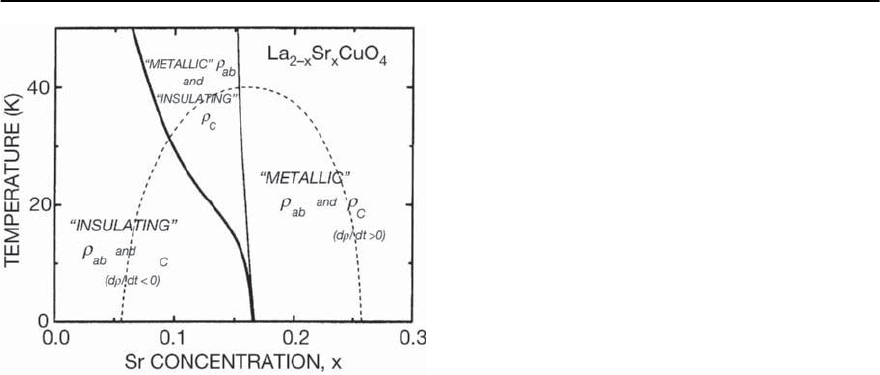
734 M.B. Maple et al.
Fig. 13.98. Temperature − Sr concentration (T–x) phase di-
agram of the La
2−x
Sr
x
CuO
4
system,aftersuperconductivity
has been suppressed by an intense pulsed magnetic field.
The insulator-metal crossover occurs near optimum dop-
ing and a new insulating regime is revealed, in which the
electrical resistivity diverges as the logarithm of the tem-
perature. The dashed line represents the T
c
vs x curve in
zero field and the two solid lines delineate the insulating
ab
and
c
, metallic
ab
and insulating
c
, and metallic
ab
and
c
regions in the normal state accessed by high magnetic
fields, after [666]
On the other hand, using the nearly antiferromag-
netic Fermi liquid description of planar quasiparti-
cles, Stojkovic and Pines [664] have shown that the
anomalous temperature dependence of the Hall an-
gle could result from highly anisotropic scattering at
different regions of the Fermi surface. A review of
magnetoresistance and Hall effect studies of cuprate
superconductors, particularly the electron-doped
cuprates La
2−x
M
x
CuO
4
and the hole-doped system
Y
1−x
Pr
x
Ba
2
Cu
3
O
7−ı
, can be found in Ref. [665].
Normal Ground State
The evolution of the normal ground state of the
cuprates as a function of dopant concentration is
particularly interesting.This is reflected in the tem-
perature dependences of the ab-plane and c-axis
electrical resistivities
ab
(T)and
c
(T) [667]. Both
ab
(T)and
c
(T) exhibit insulating behavior (i.e.,
d/dT < 0) in the under-doped region,
ab
(T)is
metallic (i.e., d/dT > 0) and
c
(T) is insulating
or metallic in the optimally-doped region, depend-
ing on the system, and
ab
(T)and
c
(T)areboth
metallic in the over-doped region. The linear T-
dependence of
ab
(T) and the insulating behavior
of
c
(T) suggest two dimensional non-Fermi liquid
behavior near the optimally-doped region, whereas
the metallic (T) ∼ T
n
with n > 1 reflects a ten-
dency towards three dimensional Fermi liquid be-
havior over-doped region. Measurements in 61-tesla
pulsed magnetic fields to quench the superconduc-
tivity have been particularly useful in elucidating
the evolution of
ab
(T)and
c
(T) with dopant con-
centration in the La
2−x
Sr
x
CuO
4
system [666]. Both
ab
(T)and
c
(T) were found to exhibit a − ln T di-
vergence in the under-doped region, indicative of a
three dimensional non-Fermi liquid [668]. Shown
in Fig. 13.98 is the temperature-Sr concentration
(T − x) phase diagram of the La
2−x
Sr
x
CuO
4
system,
after the superconductivity has been suppressed by
an intense pulsed magnetic field [666].The insulator-
metal crossover occurs near optimum doping and a
new insulating regime is revealed, in which the elec-
trical resistivity diverges as the logarithm of the tem-
perature.
Asan exampleof theevolutionof
ab
(T)and
c
(T)
with doping,we again refer to theY
1−x
Pr
x
Ba
2
Cu
3
O
7−ı
system.Shown in Fig.13.99are
ab
(T)and
c
(T)data
forY
1−x
Pr
x
Ba
2
Cu
3
O
7−ı
single crystals in the range of
Pr concentrations 0 ≤ x ≤ 0.55 [669]. The following
features in the
ab
(T)and
c
(T) data in Fig.13.99 are
evident: a nonmonotonic evolution of
c
(T)withx,
the transformation of both
ab
(T)and
c
(T)from
metallic to semiconducting with x,andthecoexis-
tence of metallic
ab
(T) and semiconducting
c
(T)
for a certain range of doping. The nonmonotonic
variation of
c
(T)withx in Fig. 13.99(b) can be de-
scribed with a phenomenological model [669] that
assumes that the c-axis conductivity takes place via
incoherent elastic tunneling between CuO
2
bilayers
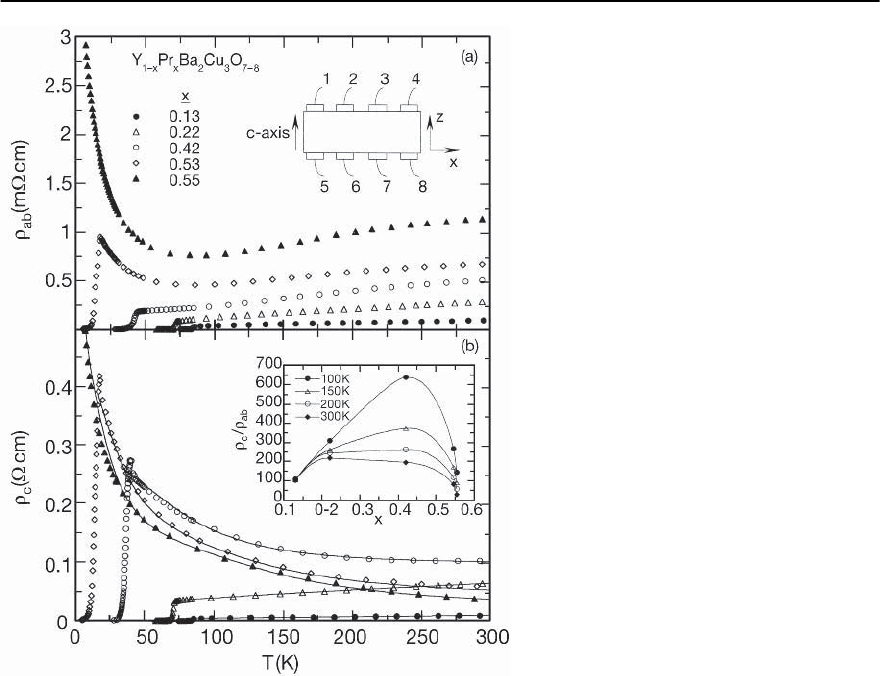
13 Unconventional Superconductivity in Novel Materials 735
Fig. 13.99. (a) In-plane resistivity
ab
(T)
and (b) out-of-plane resistivity
c
(T)for
Y
1−x
Pr
x
Ba
2
Cu
3
O
7−ı
single crystals. The solid
lines in (b) are fits to the data using a model
described in [669]. Inset (a): The configuration
of leads used in the measurements. Inset (b):
Anisotropy
c
/
ab
vs Pr concentration x at dif-
ferent temperatures. The solid lines are guides
to the eye,after [669]
and CuO chain layers with a gap in the energy spec-
trum of the CuO chains (solid lines in Fig. 13.99(b)).
Pseudogap
Perhaps the most remarkable aspect of the normal
state is the pseudogap in the charge and spin ex-
citation spectra of under-doped cuprates [610]. The
pseudogap has been inferred from features in various
transport, magnetic, and thermal measurements in-
cluding
ab
(T) [671–673]; R
H
(T) [674], thermoelec-
tric power S(T) [675],NMR Knight shift K(T) [676],
NMR spin-lattice relaxation rate 1/T
1
(T) [677–679],
magnetic susceptibility (T) [674], neutron scatter-
ing [680], and specific heat C(T) [681], as well as
spectroscopic measurements such as infrared ab-
sorption [682–684] and ARPES [670,685].
An example of the features in
ab
(T) that are asso-
ciated with the pseudogap can be seen in the
ab
(T)
data displayed as in Figs.13.91(a) and 13.99(a) for the
Y
1−x
Pr
x
Ba
2
Cu
3
O
7−ı
system. As the system becomes
more under-doped with increasing x,
ab
(T)devi-
ates from linear behavior at higher temperature at
a characteristic temperature T
∗
which represents a
crossover into the pseudogap state at T < T
∗
.
The transport, thermal, magnetic, and infrared
studies of the pseudogap have been carried out on
several cuprate materials, including LSCO, YBCO–
123, YBCO–124, and BSCCO–2212, while the ARPES
investigations of the pseudogap have mainly fo-
cused on BSCCO, although ARPES measurements
have also been made on oxygen-deficient oxygen-
deficient YBCO.
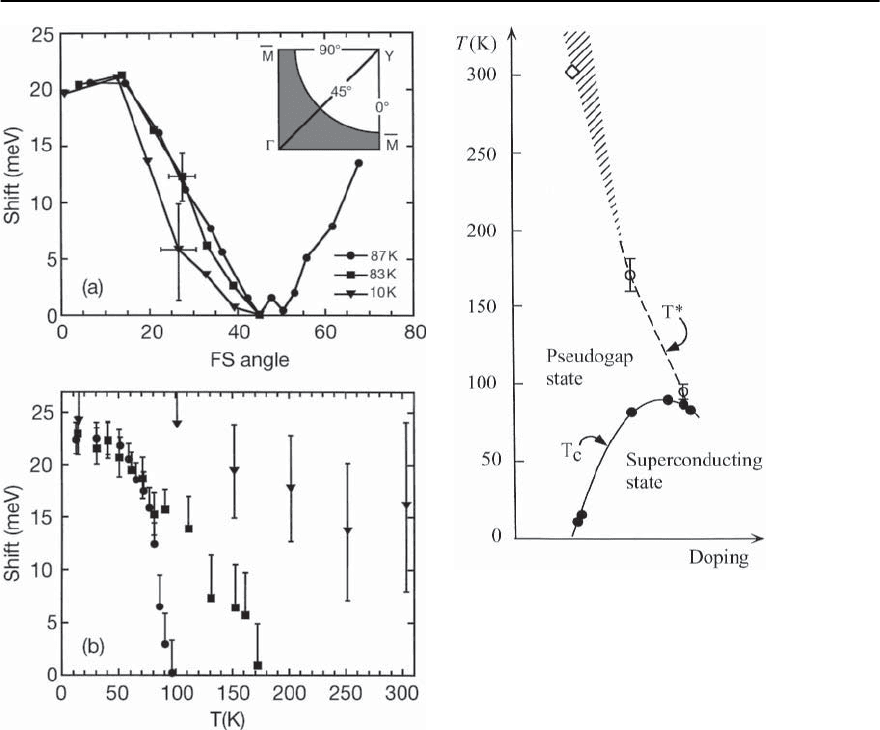
736 M.B. Maple et al.
Fig. 13.100. Momentum and temperature dependence of
the energy gap estimated from leading edge shifts of
ARPES spectra for BSCCO–2212. (a): k-dependence of the
gap in the T
c
= 87K,83K,and10Ksamples,measuredat
14 K.The inset shows the Brillouin zone with a large Fermi
surface (FS) closing the (, ) point, with the occupied
region shaded. (b): Temperature dependence of the maxi-
mum gap in a near-optimal T
c
=87Ksample(circles), and
two underdoped samples with T
c
=83K(squares)and
T
c
=10K(triangles), after [670]
The ARPES measurements reveal several striking
aspects of the pseudogap.The magnitude of the pseu-
dogap has the same k-dependence in the ab plane as
the magnitude of the superconducting energy gap,
with maxima in the directions of k
x
and k
y
and
minima at 45
◦
to these directions. In fact, the sym-
Fig. 13.101. Schematic phase diagram of BSCCO–2212 as
a function of doping. The filled symbols represent val-
ues of T
c
determined from magnetic susceptibility mea-
surements. The open symbols are values of T
∗
at which
the pseudogap closes, derived from the data shown in
Fig.13.100, after [670]
metry is consistent with d
x
2
−y
2
symmetry inferred
from Josephson tunneling measurements on hole-
doped cuprates discussed previously. Furthermore,
measurements of the temperature dependence of the
pseudogap at the angles where it is a maximum show
thatthe superconductinggapgrowscontinuously out
of the pseudogap and that the value of the sum of
both gaps at low temperatures is constant, indepen-
dent of the temperature T
∗
at which the pseudogap
opens, or T
c
.Thisisinmarkedcontrasttothesit-
uation in conventional superconductors where the
energy gap is proportional to T
c
.
These features of the pseudogap are illustrated
in Figs. 13.100(a) and 13.100(b) which show the
k-dependence of the energy gap and the depen-
dence of the maximum gap on temperature from
the ARPES measurements of Ding et al. [670] on

13 Unconventional Superconductivity in Novel Materials 737
Fig. 13.102. Tunneling spectra for Bi2212 mea-
sured at various temperatures indicated in the
figure. The conductance scale corresponds to
the 293 K spectrum; the other spectra have been
offset vertically for clarity, after [686]
BSCCO–2212 samples with values of T
c
of 87 K, 83
K, and 10 K. The pseudogap and superconducting
regions for BSCCO–2212 derived from the ARPES
measurements of Ding et al. [670] are summarized
in the temperature T
c
vs charge carrier doping plot
in Fig. 13.101.
Recently, direct measurements of the quasipar-
ticle density of states (DOS) by scanning tunnel-
ing spectroscopy on Bi
2
Sr
2
CaCu
2
O
8+ı
(Bi2212) sin-
gle crystals as a function of oxygen doping and tem-
perature were made by Renner et al. [686]. It was
found that the shape of the DOS in the supercon-
ducting state is essentially doping independent, the
pseudogap above T
c
scales with the superconducting
gap, and the pseudogap is also present in overdoped
samples. Both gaps were found to be essentially tem-
perature independent. Tunneling spectra at various
temperatures between 4.2 K and 293.2 K for Bi2212
are shown in Fig. 13.102.
In subsequent work, the temperature dependence
of the quasiparticle density of states of over-doped
Bi
2
Sr
2
CuO
6+ı
(Bi2201) single crystals was measured
between 275 mK and 82 K by means of scanning tun-
neling spectroscopy [687].Below T
c
=120 K,thespec-
tra exhibit a gap with well defined coherence peaks
at ± greater than about 12 meV, which disappears
at T
c
.AboveT
c
, the spectra display a clear pseudo-
gap of the same magnitude, gradually filling up and
vanishing at T
∗
≈ 68 K. This gap value is extremely
large for a T
c
of 10 K and is ∼ 7 times larger than the
BCS d-wave prediction
BCS
=1.8 meV [688]. This
implies a very high ratio 2
p
/k
B
T
c
≈28, a value even
larger than 2
p
/k
B
T
c
≈ 10 for Bi2212 at equivalent
doping, showing that superconductivity is far from
BCS-like in Bi2201, even in the over-doped regime.
This work also revealed that the ratio of
p
and T
∗
is the same as found in other high T
c
cuprate super-
conductors. This is illustrated in the plot of T
∗
/T
c
vs
2
p
/k
B
T
c
shown in Fig. 13.103 where it can be seen
that the data are well represented by the BCS rela-
tion 2
p
/k
B
T
∗
=4.3, where T
c
has been replaced by
T
∗
.ThissuggeststhatT
∗
, rather than T
c
, reflects the
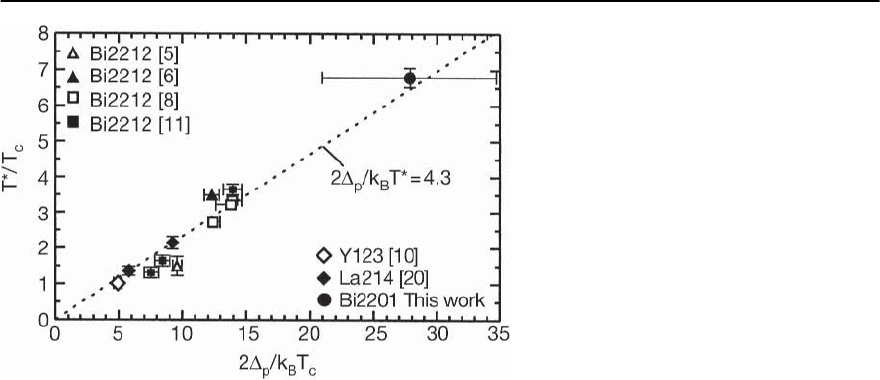
738 M.B. Maple et al.
Fig. 13.103. T
∗
/T
c
vs 2
p
/k
B
T
c
for various
cuprate superconductors compared to the
mean field relation 2
p
/k
B
T
∗
=4.3, where T
c
has been replaced by T
∗
. Error bars have been
extracted from the references given by Kugler
et al. indicated in the figure, after [687]
mean field critical temperature of cuprate supercon-
ductors and favors models which involve precursor
pairing as the origin of the pseudogap phase.
Electronic Inhomogeneity
Stripes, a complex form of electronic self-
organization,have been observed in certain cuprates
at low doping near the onset of the superconducting
regime [689]. The stripes are believed to consist of
mobile charge carriers in the CuO
2
planes that are
confined to narrow one-dimensional lines (“charge
stripes”) and separated by insulating regions which
exhibit antiferromagnetic order,similar to that which
occurs in the parent Mottinsulatorssuch as La
2
CuO
4
in which electrons are localized as a result of strongly
repulsive electron–electron interactions. Thus, there
should be large anisotropy in electrical conductivity
between directions parallel and perpendicular to the
stripes. The stripes are particulary prominent at low
doping where T
c
is low and substantially weakened at
higher doping where T
c
is a maximum.This suggests
that stripes and superconductivitycompete with one
another,and many researchers believe that these two
phases arise from a common underlying mechanism.
Some researchers believe that the stripes are actually
a precondition for high T
c
superconductivity in the
cuprates.
The first evidence for static spin and charge or-
der in cuprates was obtained in a neutron scatter-
ing study of a single crystal of La
1.6−x
Nd
0.4
Sr
x
CuO
4
by Tranquada et al. [690]. In this material, the par-
tial substitution of Nd for La results in a change
in crystal structure from the usual low temperature
orthorhombic (LTO) phase to the low temperature
tetragonal (LTT) phase, and a depression of T
c
near
x = 0.125. The LTO-LTT structural transition occurs
at ∼70 K in La
1.6−x
Nd
0.4
Sr
x
CuO
4
forx = 0.12,and ev-
idence for static spin and charge stripes comes from
neutron scattering as well as x-ray scattering exper-
iments [690, 691]. In the La
2−x
Sr
x
CuO
4
system, in-
elastic neutron scattering experiments have yielded
evidence for dynamical two-dimensional spin cor-
relations characterized by an incommensurate wave
vector [692–694].The characteristic wave vectorsas-
sociated with magnetic scattering in La
1.85
Sr
0.15
CuO
4
and La
1.48
Nd
0.4
Sr
0.12
CuO
4
are essentially identical.
Thus, the major difference between the two systems
appears to be the static vs dynamic character of the
correlations. This similarity suggests that dynami-
cal stripe correlations of both spin and charge ex-
ist in superconducting La
1.85
Sr
0.15
CuO
4
.Anintrigu-
ing question is what roles these dynamical spin and
charge stripe correlations play in the anomalous nor-
mal stateproperties and thesuperconducting pairing
mechanism in the cuprates.
Recently, Dumm et al. [695] performed infrared
(IR) spectroscopy measurements on single crystals
of La
1.97
Sr
0.03
CuO
4
, a weakly doped phase of one
of the prototypical high T
c
superconducting sys-
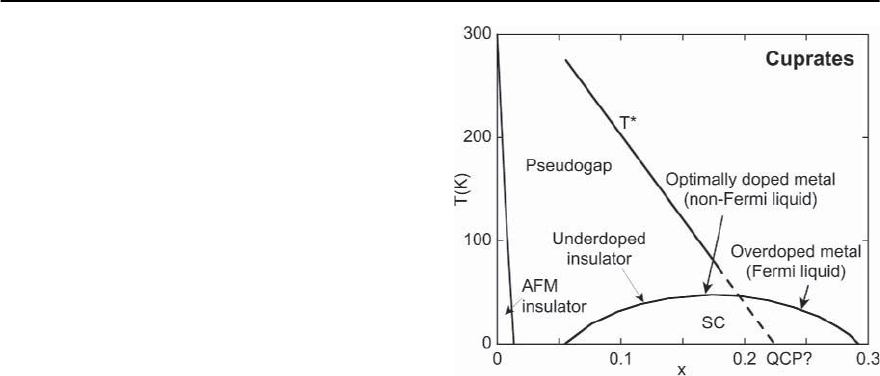
13 Unconventional Superconductivity in Novel Materials 739
tems La
2−x
Sr
x
CuO
4
. The existence of spin stripes in
the La
2−x
Sr
x
CuO
4
system has been well documented
through extensive neutron scattering and transport
studies on this system by Matsuda et al. [696]. The
IR spectroscopy measurements revealed anisotropy
of both the electronic conductivity and the lattice
dynamics. The phonon mode data indicate that the
spin stripes may be accompanied by charge order-
ing which appears to be quasi-static on the time
scale of phonon frequencies. Significant anisotropy
of the electronic response within the CuO
2
planes
was found, with enhancement of the conductivity
along the stripe direction. The authors conclude that
theresultsuncovera more complexelectronicbehav-
ior due to stripes that is beyond an idealized picture
of strictly one-dimensional charge channels embed-
dedinanantiferromagneticinsulator.
Extensive low temperature scanning tunneling
microscopy/spectroscopy (STM/S) studies have been
performed on optimally-doped Bi
2
Sr
2
CaCu
2
O
8+ı
(Bi2212) [697]. The measurements reveal electronic
inhomogeneities that are reflected in spatial varia-
tions in both the local density of states spectrum and
the superconducting energy gap.Thesevariations are
correlated spatially and have a very short length scale
of ∼14 Å.
Recent scanning tunneling spectroscopy stud-
ies of the high T
c
superconductor Bi
2
Sr
2
CaCu
2
O
8+ı
(Bi2212) have revealed weak, incommensurate
spatial modulations in the tunneling conduc-
tance [698]. Fourier analysis of images of these
energy-dependent modulations yield the disper-
sion wave vectors. Comparison of the dispersions
with photoemission spectroscopy data indicate that
quasiparticle interference, due to elastic scattering
between characteristic regions of momentum space,
provides a consistent explanation for the conduc-
tance modulations, without the need to invoke an-
other order parameter. These results implicate quasi-
particle scattering processes as candidates to ex-
plain other incommensuratephenomena in cuprates.
However, these results do not rule out stripes in
Bi2212, but they show that stripes are not needed
to explain the undulations on the surface of BSCCO
seen earlier by STM.
Fig. 13.104. Generic temperature T
∗
-dopant concentration
x phase diagram for cuprates (schematic) The lines labeled
T
N
and T
c
delineate the antiferromagnetic (AFM) and su-
perconducting regions, respectively. The line denoted T
∗
represents the crossover into the pseudogap state. The
dashed line is a linear extrapolation of T
∗
(x) to a possi-
ble quantum critical point (QCP)
Generic Phase Diagram
Based upon investigations on LSCO, YBCO–123,
YBCO–124, BSCCO, and other systems, one can con-
struct a generic T − x phase diagram, represented
schematically in Fig. 13.104. The phase diagram is
very richand contains insulating,antiferromagnetic,
superconducting, pseudogap, two-dimensional (2D)
non-Fermi liquid like, and three-dimensional (3D)
Fermi liquid like regions. This version of the phase
diagram is similar to the one proposed by Tallon and
Loram [699] who examined the temperature depen-
dence of the NMR Knight shift and relaxation rate,
entropy, electrical resistivity, infrared conductivity,
Raman scattering, ARPES and electron tunneling
data. In this phase diagram, the maximum value of
T
c
occurs at a value of the hole concentration p
max
≈
0.16, while the critical hole concentration p
cr
where
T
∗
vanishes (quantum critical point) is p
cr
≈ 0.19.
A number of models and notions have been pro-
posed to explain the part of the phase diagram de-
lineated by the curves of T
∗
and T
c
vs x (for exam-
ple, [700–707]). Many of these models involve the
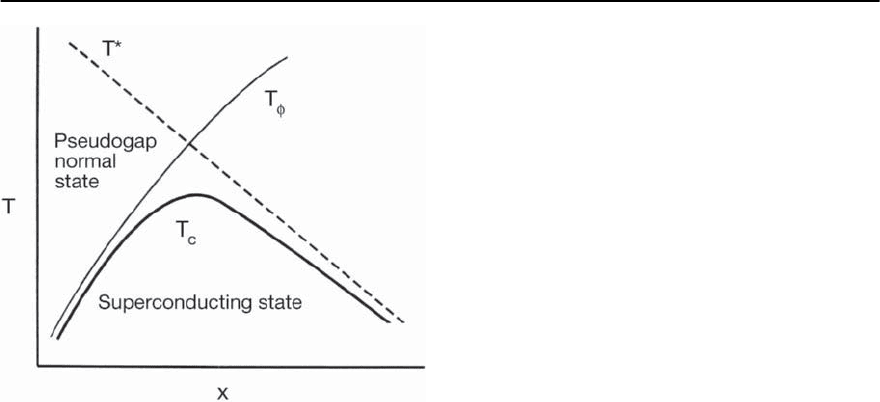
740 M.B. Maple et al.
Fig. 13.105. Schematic temperature T
∗
-dopant concentra-
tion x phase diagram for the cuprates. The dashed line
labeled T
∗
represents the temperature below which some
type of local pairing occurs leading to a suppression of
low energy excitations and the formation of the pseudo-
gap. The solid line labeled T
denotes the temperature be-
low which phase coherence develops, resulting in super-
conductivity. The dark solid line labeled T
c
delineates the
superconducting region
local pairing of electrons (or holes) at the temper-
ature T
∗
leading to a suppression of the low lying
charge and spin excitations and the formation of
the normal state pseudogap, followed by the onset
of phase coherence at T
c
that results in supercon-
ductivity.Since the phenomenon of superconductiv-
ity involves coherent pairing, a bell shaped curve of
T
c
vs x results as shown schematically in Fig. 13.105.
For example,in resonating valence bond(RVB) mod-
els[654,700–703,706],whichincorporatespin-charge
separation into “spinons” with spin =1/2and
charge q =0and“holons”with =0andq =+e,
where e is the charge of the electron, the spinons
become paired (spin pseudogap) at T
∗
and coher-
ent pairing of holons (Bose–Einstein condensation)
occurs at T
, resulting in superconductivity.
As illustrated in Fig. 13.105, the temperature T
∗
at
which the pseudogap forms decreases with doping
level x from a value much larger than T
c
at low dop-
ingtoavaluecomparabletoT
c
near optimal dop-
ing level where T
c
is a maximum. Extrapolation of
T
∗
(x) to 0 K suggests that there is a QCP within the
superconducting region, as depicted in Fig. 13.105.
A number of theories have been developed that re-
late the high T
c
superconductivity in the cuprates to
the existence of a QCP where T
∗
(x) vanishes. It is
interesting that superconductivity in certain heavy
fermion f -electron materials (e.g., CeIn
3
,CePd
2
Si
2
)
is found in the vicinity of a magnetic QCP and T
c
has an inverted parabolic dependence on pressure,
the control parameter. Further evidence for a con-
nection between the pseudogap phase and super-
conductivity is the similarity in the magnitude of
the superconducting energy gap and its variation
with direction about the Fermi surface; e.g., as dis-
cussed above, the pseudogap and the superconduct-
ing gapis BSCCO bothhaved
x
2
−y
2
symmetry,accord-
ing to ARPES measurements. Recent Nernst effect
measurements on the La
2−x
Sr
x
CuO
4
system in high
magnetic fields have provided evidence for vortices
(or vortex-like excitations) at temperatures signifi-
cantly above T
c
in the pseudogap phase [708,709]. In
the Nernst effect, a thermal gradient is applied to the
sample in a magnetic field, and vortices are detected
by the large transverse electric field produced as the
vortices diffuse down the gradient. In underdoped
La
2−x
Sr
x
CuO
4
,the vortex-like excitations extend to a
T
vortex
(x)ismuchlargerthanT
c
and about one-half
of T
∗
(x)(i.e.,T
vortex
(x) tracks T
∗
(x)) [708]. In over-
doped La
2−x
Sr
x
CuO
4
, the upper critical field curve
H
c2
(T) does not end at the zero field critical tem-
perature T
c
, but at a much higher temperature [709].
These results suggest that T
c
corresponds to a loss
in phase rigidity, rather that a vanishing of the pair-
ing amplitude. Recently, evidence for vortex-like ex-
citations above T
c
were obtained from in-plane mag-
netoresistivity measurements onY
1−x
Pr
x
Ba
2
Cu
3
O
7−ı
single crystals [710].
13.5.6 Concluding Remarks
The past two decades of research have consistently
yielded a rich variety of new compounds, new phe-
nomena, and new insights into the nature of su-
perconductivity. When heavy-fermion superconduc-
tivity was first discovered in CeCu
2
Si
2
in 1979 by
Steglich and coworkers, the coexistence of mag-
netism and superconductivity had only been es-
